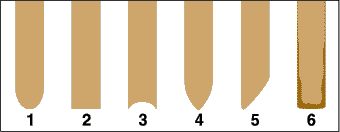
To prevent serious damage to wheels and equipment, stay aware of your machine's cutting action by inspecting the edge of the wheel for signs of trouble.
ROUND FACE (fig 1) - Normal when using the correct wheel to cut large solids.
SQUARE FACE (fig 2) - Normal when using the correct wheel to cut small solids, structural shapes, medium wall pipe and tubing.
CONCAVE FACE (fig 3) - Normal when using the correct wheel to cut tubing and thin-wall sections.
POINTED FACE (fig 4) - Indicates wheel is too hard. May cause binding, breakage and excessive burr on the cut.
CHISEL FACE (fig 5) - Wet cutting problem. Usually indicates wrong application of coolant. May cause breakage and crooked cuts.
GLAZED SIDES & FACE (fig 6) - Indicates wheel is too hard or cutting too slow. Requires excessive pressure and power to cut. Causes breakage, excessive burr and burn.

